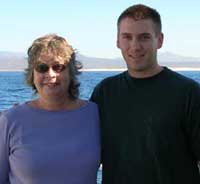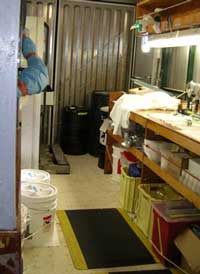


|
The Project Part 1: Part 2: Part 3:
| Daily JournalJanuary 28, 2005:
|
Carolyn and Greg
Inside the rad van
Greg at his business |
Today we finally rounded the tip of Baja Mexico and entered into the Sea of Cortez. The view from the stern is blocked, however, by an old cargo container with a door in the side known as the “rad van,” where Greg and Carolyn will do much of their work. The rad van is so named because the experiments run inside involve radioactive material. It’s self-contained, air-conditioned, and has no windows. Greg uses 54Mn (an isotope of manganese) to trace how fast bacteria turn dissolved Mn (manganese) to a precipitate (solid) form. 30-50% of the ocean floor is covered by manganese, so it’s known that it’s precipitating, and that bacteria are doing it, but not which ones. Greg hopes that by growing bacteria, putting a known amount of the isotope in it, he can use an instrument to determine how much of the isotope was turned into the particulate form and establish a rate at which it was done. Running the experiment in different ways—in extreme heat for example—should help determine which organisms are involved.
Q: Find on a map how far it is from San Diego to Cabo San Lucas on the tip of the Baja peninsula. We reached this point at 11 am. It took us three full days plus two hours to get there. How many miles/hr are we traveling on average if you assume we’ve traveled that distance? We’re estimated to reach our first station at 6 pm tomorrow night. At that speed, how many miles will we have traveled by then?

The tip of Baja. This rugged, arid region is a contrast
to the ocean that surrounds it.
![]()



